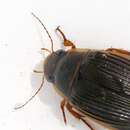en
names in breadcrumbs


European scientists are trying to extend protection to the Dytiscus marginalis beetles and other water beetles by going further than just restricting collection. The Water Beetle Specialist Group and the Saproxylic Invertebrate Project are two organizations that have been hard at work fostering the education, biodiversity, and conservation of the water beetle.
(Evans and Bellamy 1996)
US Federal List: no special status
CITES: no special status
Beetles of this family eat on several aquatic animals, including fish! Adults and larva are very carnivorous and search for their prey by diving and swimming actively through zones in the water where light reaches. (Borror and White 1970, Gullan and Cranstan 1994)
Biogeographic Regions: palearctic (Native )
Dytiscus marginalis do not exist below certain elevations and are found in mountain lakes or ponds or in collections of melted snow. Adults hibernate under stones to avoid being frozen in the water during colder seasons. (Evans and Bellamy 1996) These beetles are active anywhere by the ice, where they exploite the oxygen bubbles that usually occur under ice along with dissolved oxygen.(Crowson 1981)
Terrestrial Biomes: tundra ; mountains
Aquatic Biomes: lakes and ponds
These aquatic diving beetles have bodies that are compressed top to bottom and keeled laterally and ventrally. They have hydrodynamic bodies and average 27mm in length.
Range mass: 30 (high) g.
Other Physical Features: ectothermic ; bilateral symmetry
Mating occurs in or near water by the Dytiscids. Beetles of this species undergo a complete metamorphosis. Eggs are laid underwater and are usually placed in special cavities cut in the stems of emergent plants (Crowson 1981). Eggs hatch within a few weeks (McCafferty 1998).
The great diving beetle (Dytiscus marginalis) is an aquatic diving beetle native to Europe and northern Asia, and in the UK is common in Wales, much of England and southern Scotland but less common on chalk and in the far north.[1] The great diving beetle, true to its name, is a rather large insect. The larvae can grow up to 60 millimetres (2.4 in) in length, while the adults are generally 27–35 millimetres (1.1–1.4 in).
These beetles live in fresh water, either still or slow-running, and seem to prefer water with vegetation. They are dark-coloured (brown to black) on their back and wing cases (elytra) and yellow on their abdomen and legs. The male's wing cases are shiny, while those of the female are finely grooved. A voracious predator, this beetle hunts a wide variety of prey including small fish. The first two pairs of legs of the male are equipped with numerous suction cups, enabling them to obtain a secure grip while mating, and on their prey.[2][3]
They are able fliers, and fly usually at night. They use the reflection of moonlight to locate new water sources. This location method can sometimes cause them to land on wet roads or other hard wet surfaces.
Before they dive, they collect air bubbles in their wing cases which goes through the spiracles. The jaws of a great diving beetle are strong compared to their body size.
The beetle reproduces by laying eggs under water in the mesophyll of an aquatic plant leaf. The incubation period is between 17 and 19 days.[4]
 Male front leg from underside
Male front leg from underside  Adult
Adult  Larva
Larva The great diving beetle (Dytiscus marginalis) is an aquatic diving beetle native to Europe and northern Asia, and in the UK is common in Wales, much of England and southern Scotland but less common on chalk and in the far north. The great diving beetle, true to its name, is a rather large insect. The larvae can grow up to 60 millimetres (2.4 in) in length, while the adults are generally 27–35 millimetres (1.1–1.4 in).
These beetles live in fresh water, either still or slow-running, and seem to prefer water with vegetation. They are dark-coloured (brown to black) on their back and wing cases (elytra) and yellow on their abdomen and legs. The male's wing cases are shiny, while those of the female are finely grooved. A voracious predator, this beetle hunts a wide variety of prey including small fish. The first two pairs of legs of the male are equipped with numerous suction cups, enabling them to obtain a secure grip while mating, and on their prey.
They are able fliers, and fly usually at night. They use the reflection of moonlight to locate new water sources. This location method can sometimes cause them to land on wet roads or other hard wet surfaces.
Before they dive, they collect air bubbles in their wing cases which goes through the spiracles. The jaws of a great diving beetle are strong compared to their body size.
The beetle reproduces by laying eggs under water in the mesophyll of an aquatic plant leaf. The incubation period is between 17 and 19 days.